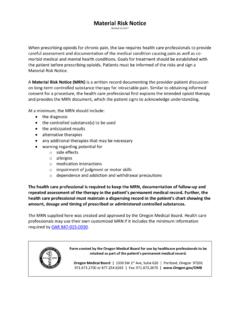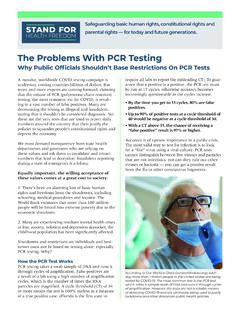Transcription of Health Promotion and Prevention Frameworks
1 Appendix A: Frameworks 1 Health Promotion and Prevention Frameworks Table of Contents Purpose .. 2 Risk and Protective Factors .. 2 Continuum of Care .. 3 Social-Ecological Model .. 5 Substance Abuse and Mental Health Services Administration (SAMHSA) s Strategic Prevention Framework (SPF) .. 7 SAMHSA s Six Center for Substance Abuse Prevention (CSAP) Strategies .. 8 Gathering of Native Americans (GONA) Approach .. 9 Community Readiness Model .. 9 Spectrum of Prevention (SoP) .. 11 Developmental Assets Framework .. 12 Health Impact Pyramid (HIP) .. 13 Association of State and Territorial Health Officials (ASTHO) Substance Misuse and Addictions Prevention Framework.
2 14 The Centers for Disease Control and Prevention s (CDC): Four Domains of Chronic Disease Prevention .. 15 CADCA s Seven Strategies to affect Community Change .. 15 Other Helpful Resources .. 17 Appendix A: Frameworks 2 Purpose The purpose of this document is to provide an overview of some commonly used alcohol and other drug Prevention Frameworks . The Center for Substance Abuse Prevention (CSAP) six Prevention strategies and Strategic Prevention Framework are referenced in the 21-23 ADPEP Guidance. Those and additional Frameworks are provided as a reference and resource for those new to the ADPEP role or those wanting to learn more about some key Prevention Frameworks as they can be very helpful when developing workplans.
3 Risk and Protective Factors The Risk and Protective Factor theory is a field of study pioneered by David Hawkins and Richard Catalano. While Prevention planners cannot change risky behaviors, mental or behavioral Health disorders, or substance misuse problem directly, we can work through underlying risk and protective factors that influence the problems our communities face. Assessing the risk and protective factors that contribute to substance misuse or substance use disorders help practitioners select appropriate interventions. Many factors influence a person s chance of developing a mental or behavioral Health disorder and/or substance use disorder.
4 Effective Prevention focuses on reducing those risk factors, and strengthening protective factors, that are most closely related to the problem being addressed. What s important is we identify strategies in our communities that fit both our community and the root causes (underlying factors, risk factor, intervening variables). Risk factors are characteristics at the biological, psychological, family, community, or cultural level that precede and are associated with a higher likelihood of negative outcomes. Risk factors vary greatly according to age, social and psychological development, ethnic/cultural identity, and surroundings.
5 Protective factors are characteristics associated with a lower likelihood of negative outcomes or that reduce a risk factor s impact. Protective factors may be seen as positive countering events. Though preventive interventions are often designed to produce a single outcome, both risk and protective factors can be associated with multiple outcomes. For example, traumatic life events are associated with substance use as well as anxiety, depression, and other behavioral Health issues. Prevention efforts targeting a set of risk or protective factors have the potential to produce positive effects in multiple areas. All people will have some mix of risk and protective factors.
6 What is important in the field of Prevention is striking a balance between these so that the effects of protective factors outweigh the effects of risk factors. Appendix A: Frameworks 3 Hawkins JD, Catalano RF, Miller JY. Risk and protective factors for alcohol and other drug problems in adolescence and early adulthood: implications for substance abuse Prevention : Continuum of Care As we consider risk and protective factors, it is also important to distinguish between Health Promotion , Prevention , treatment, and maintenance while showing the interrelation among Appendix A: Frameworks 4 each stage. The Institute of Medicine s Continuum of Care helps illustrate this difference and makes a distinction between three levels of Prevention : universal, selective, and indicated.
7 It is important for ADPEP grantees to recognize their role in supporting Prevention efforts within a broad continuum of care. Mental Health Promotion interventions: Usually targeted to the public or a whole population. Interventions aim to enhance individuals ability to achieve developmentally appropriate tasks (competence) and a positive sense of self-esteem, mastery, well-being, and social inclusion, and strengthen their ability to cope with adversity. Example: Programs based in schools, community centers, or other community-based settings that promote emotional and social competence through activities emphasizing self-control and problem solving.
8 Universal preventive interventions: Targeted to the general public or a whole population (like a county, city, neighborhood, or school) that has not been identified on the basis of individual risk. The intervention is desirable for everyone in that group. Universal direct strategies - Directly serve an identifiable group of participants - Have not been identified based on individual risk - Examples are school curriculums, after-school programs, parenting classes, party patrol - Also include interventions involving interpersonal, ongoing and repeated contact, such as coalition building Universal indirect strategies Appendix A: Frameworks 5 - Support population-based programs and environmental strategies - Examples include establishing alcohol, tobacco, and other drug (ATOD) policies Selective preventive interventions.
9 Targeted to subgroups of the general population that are considered at risk of engaging in substance misuse by their exposure to specific risk factors and are recruited to participate in the Prevention effort specifically because of that group s risk profile. Example: Curriculum-based programs for children of substance-abusing parents, and programs for families living in high-crime or impoverished neighborhoods. Programs offered to children exposed to risk factors, such as parental divorce, parental mental illness, death of a close relative, abuse, or community trauma, to reduce risk for adverse mental, emotional, and behavioral outcomes.
10 Indicated preventive interventions: Targeted to individuals who are experiencing early signs of substance use and other related problem behaviors associated with substance use, but who haven t reached the point where clinical diagnosis of substance abuse can be made. Indicated Prevention approaches are used for individuals who may or may not be abusing substances but who exhibit risk factors such as school failure, interpersonal social problems, delinquency, and other antisocial behaviors. These individuals may also exhibit psychological problems such as depression and suicidal behavior, which increase their chances of developing a drug abuse problem .














